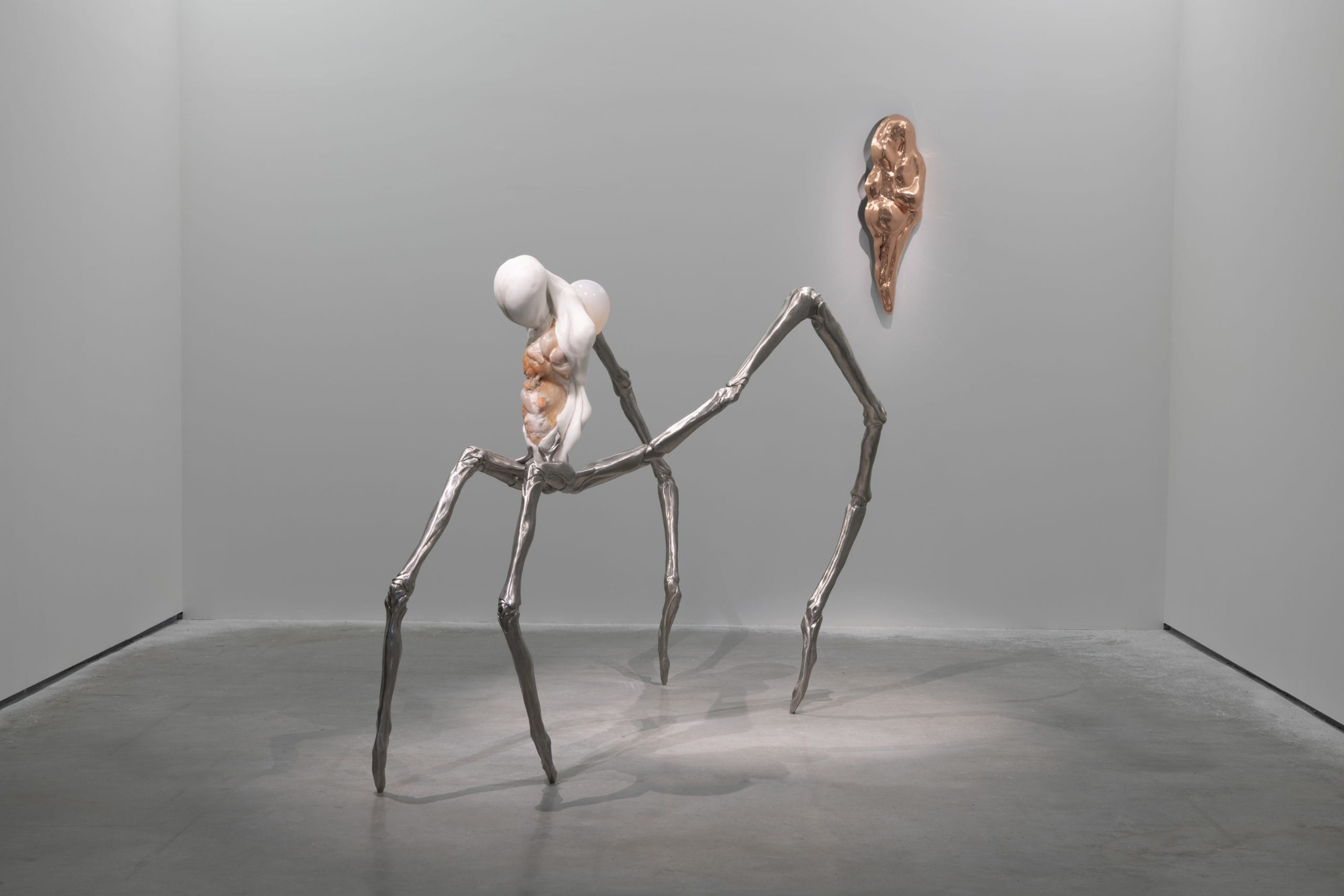The solo exhibition of Ivana Bašić’s recent works presents a unique epistemological landscape of the posthuman body, appearing as a postbiological relic — fragile yet unrelenting, caught in a process of ontological mutation. The sculptures and drawings on view explore a posthumanist vision of human evolution, wherein the work of art becomes a material foundation for speculation about the body — not as a stable referential framework of identity anchored in solid contours, but as a mutable substance through which the possibility of survival amid radical transformation is considered.
The pronounced perforation of forms follows the artist’s internal impulses, with her treatment of material emphasizing the expressive and psychological tension of the work, provoking sensations of deep unease and existential reflection. Created in media such as wax, glass, resin, stainless steel, bronze, and alabaster, Bašić’s hybrid forms evoke fluid, biomechanical bodies inhabiting the threshold between the empirical and the metaphysical. The figures that populate her imaginary are not human: they are chimerical, part insectoid, part mechanical, permeated by multiple perforated structures that imbue the works with a distinct otherworldly quality. Oscillating between hominid, mechanical, mineral, and post-organic states — neither alive nor dead, but in a liminal condition — these entities visualize matter that thinks, feels, and endures beyond the human. Bašić’s bodies are bodies in a constant state of becoming — mutant, brittle yet brutal, human and nonhuman, alive and post-life, suspended between form and its erosion.
At the core of Bašić’s practice lies a profoundly personal testimony of war, exile, and the collective trauma of the Balkans in the aftermath of the dissolution of Yugoslavia. Through a posthumanist lens, she interrogates the ways in which pressure and destruction shape not only the tissue of the body but subjectivity itself. With fragile forms, the vulnerability of the living organism in a state of existential tension, but also its defiant resilience and resistance to death, Bašić simultaneously anticipates the collapse and tragedy of an era, the grotesque of war, and the disintegration of the human in both image and form. Yet, in her sculptures, brutality and vulnerability meet without hierarchy; beauty is found in distortion, tenderness in violence, as the artist dissolves the dichotomy between the sublime and the monstrous. The sculptural forms — evoking fragile, tormented, and posthumously reconfigured bodies — are not an escape from reality but its echo: voices of bodies that have survived, disintegrated, and reassembled, following the principle of solve et coagula, offering an alternative vision of existence. Bašić’s chthonic entities, inspired by the concept of sympoiesis (collective creation), are not autonomous but emerge through merging with the Other, through the loss of form and the embrace of the unknown. In this register, the artist does not create figurative representations but rather alchemical entities that actively undergo a process of somatic-spiritual transmutation — a visualized rhythm of existence. This is a space between control and surrender, between the interior of the body and its physical boundaries, between energetic connectivity and aesthetic sublimation, representing a radical act of liberation from linear time, origin, and causality. Ivana Bašić’s ability to powerfully and convincingly articulate deeply emotional, instinctual, and psychic states of experience, emergence, and dissolution within the field of life renders these profoundly evocative figures primal, timeless, and universal.

BIOGRAPHY
Ivana Bašić (b. 1986, Belgrade) earned her degree from the University of Belgrade and received her MFA from Tisch School of the Arts in New York. Since relocating to the United States, Bašić has garnered significant critical and institutional recognition internationally, exhibiting her work at numerous leading institutions, including: Schinkel Pavillon, Berlin (2024, 2023); MO.CO La Panacée, Montpellier (2025, 2018); Lafayette Anticipations, Paris (2023); National Gallery, Prague (2021); Museum of Art+Design, Miami (2020); Het HEM, Amsterdam (2020); Contemporary Art Museum of Estonia, Tallinn (2019); Kumu Art Museum, Tallinn (2019); NRW Forum, Düsseldorf (2019); Athens Biennale (2018); Belgrade Biennale (2018); Künstlerhaus, Graz (2018); Hessel Museum of Art, New York (2017); Kunstverein Freiburg, Freiburg (2017); Whitney Museum of American Art, New York (2016), among many others. Her works are part of the permanent collections of the Whitney Museum, MO.CO Montpellier, Bangkok Kunsthalle, Zabludowicz Collection, as well as numerous private collections. Bašić is a recipient of the NYSCA/NYFA Artist Fellowship for Sculpture (2024), a two-time recipient of the Two Trees Cultural Subsidy Program (2020, 2023), and a two-time recipient of the Foundation for Contemporary Arts Emergency Grant Program (2024, 2016). Born and raised in Belgrade, she has lived and worked in New York since 2010.
Exhibition curators: Miroslav Karić, Zlata Vučetić
Author of the exhibition accompanying text: Zlata Vučetić
Exhibition producer: Nataša Lazić
Photographs: Marc Domage / MO.CO. Montpellier Contemporain
The Museum of Contemporary Art extends its gratitude to the following individuals for their support in the realization of this exhibition:
Marc Müller, Leonie Lang, Albion Jeune, Srđan Šaper.
